Service Program: Supporting Homeless Youth in Queensland, Australia
VerifiedAdded on 2020/03/02
|12
|3397
|50
Report
AI Summary
This report proposes a comprehensive service program targeting homeless youth under 16 in Queensland, Australia, addressing the critical issue of youth homelessness. The program emphasizes consumer engagement through newsletters, surveys, and consumer-led projects to assess and meet the needs of this vulnerable population. It outlines advocacy strategies involving federal, state, and local governments, aiming to secure funding and implement effective policies. The report details program implementation, including housing arrangements, community partnerships, and prevention policies. Furthermore, it describes the monitoring and evaluation processes, focusing on assessing program effectiveness and ensuring continuous improvement to achieve its primary goal: eradicating homelessness among youth through a recovery-oriented approach that prioritizes independent living and support services. The report highlights the importance of education, family support, and community awareness in the rehabilitation and integration of these children.
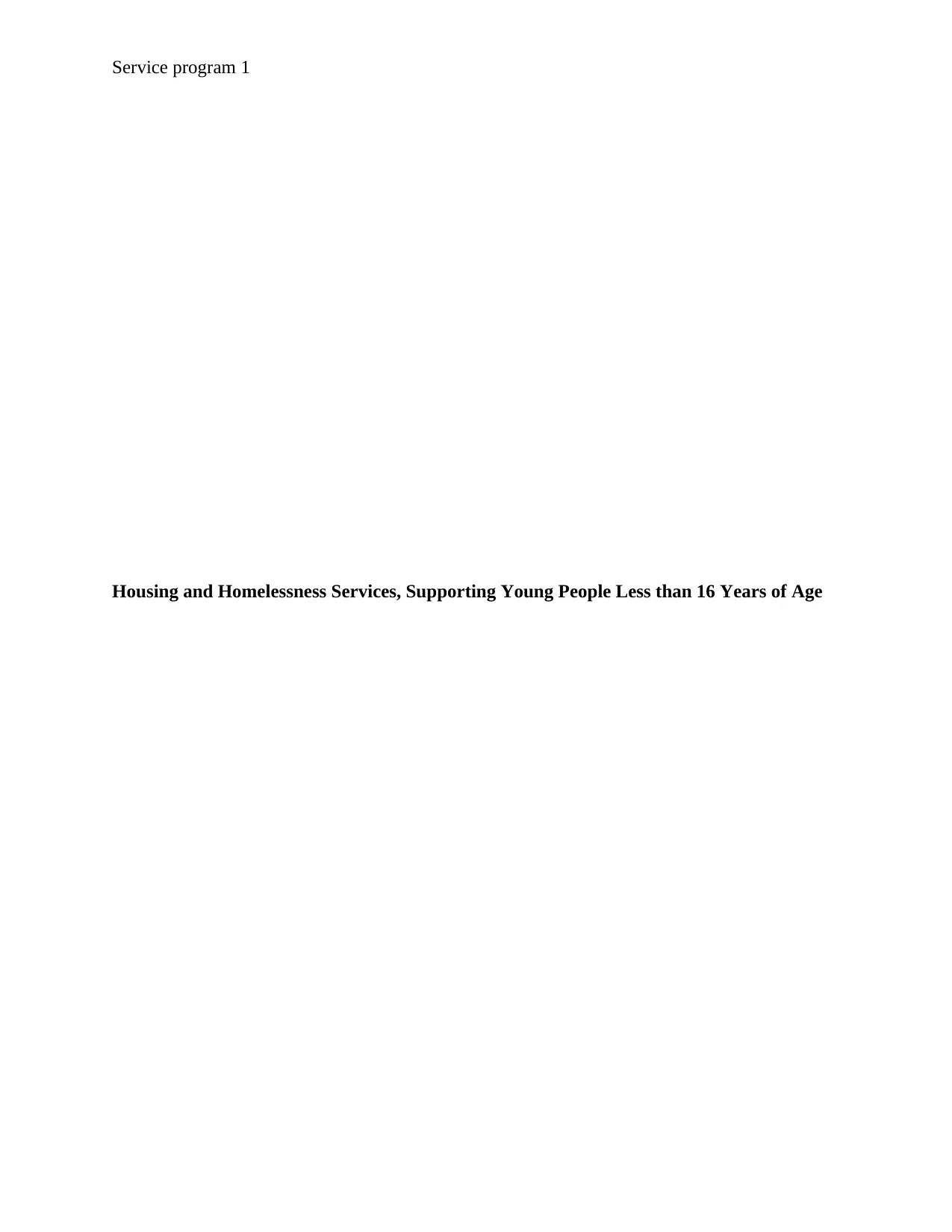
Service program 1
Housing and Homelessness Services, Supporting Young People Less than 16 Years of Age
Housing and Homelessness Services, Supporting Young People Less than 16 Years of Age
Paraphrase This Document
Need a fresh take? Get an instant paraphrase of this document with our AI Paraphraser
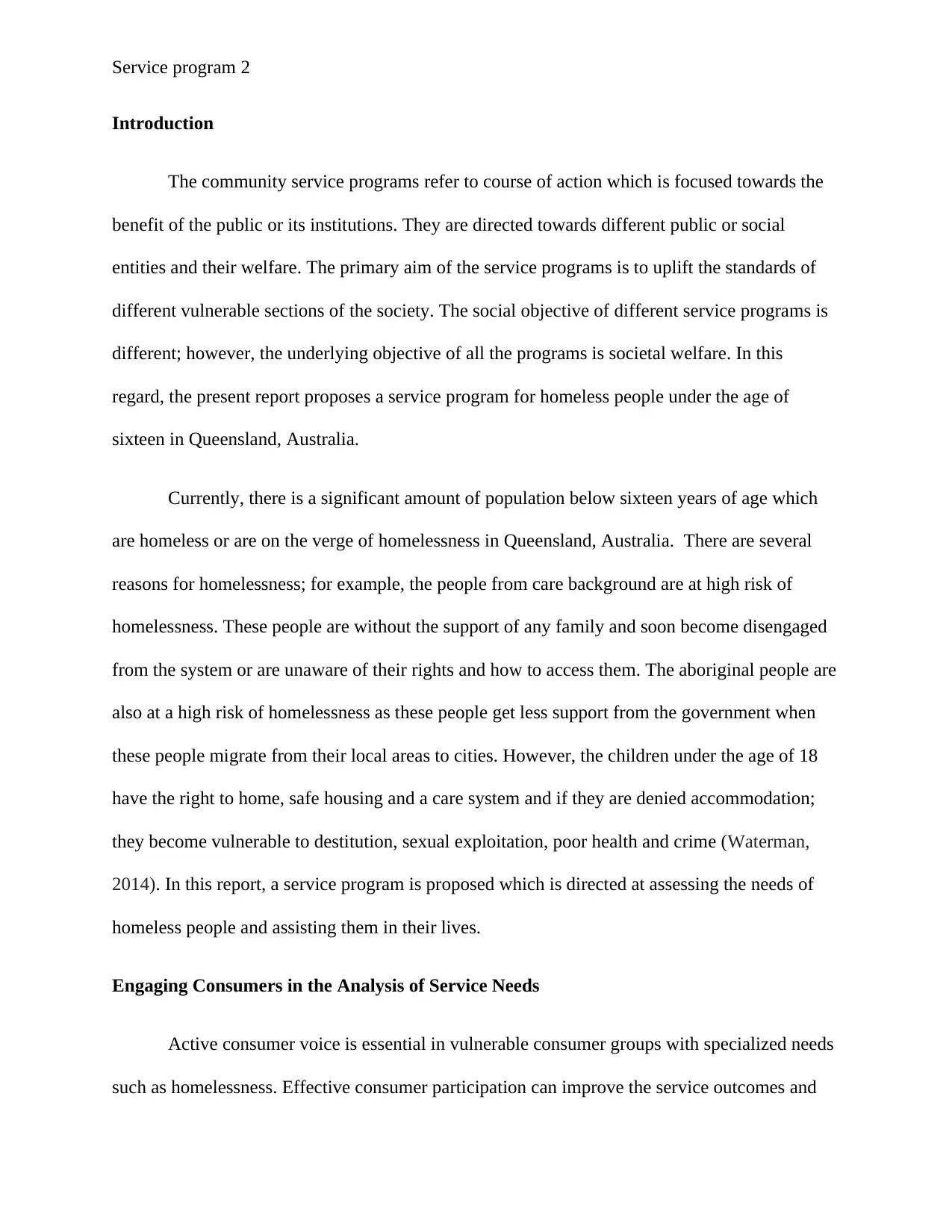
Service program 2
Introduction
The community service programs refer to course of action which is focused towards the
benefit of the public or its institutions. They are directed towards different public or social
entities and their welfare. The primary aim of the service programs is to uplift the standards of
different vulnerable sections of the society. The social objective of different service programs is
different; however, the underlying objective of all the programs is societal welfare. In this
regard, the present report proposes a service program for homeless people under the age of
sixteen in Queensland, Australia.
Currently, there is a significant amount of population below sixteen years of age which
are homeless or are on the verge of homelessness in Queensland, Australia. There are several
reasons for homelessness; for example, the people from care background are at high risk of
homelessness. These people are without the support of any family and soon become disengaged
from the system or are unaware of their rights and how to access them. The aboriginal people are
also at a high risk of homelessness as these people get less support from the government when
these people migrate from their local areas to cities. However, the children under the age of 18
have the right to home, safe housing and a care system and if they are denied accommodation;
they become vulnerable to destitution, sexual exploitation, poor health and crime (Waterman,
2014). In this report, a service program is proposed which is directed at assessing the needs of
homeless people and assisting them in their lives.
Engaging Consumers in the Analysis of Service Needs
Active consumer voice is essential in vulnerable consumer groups with specialized needs
such as homelessness. Effective consumer participation can improve the service outcomes and
Introduction
The community service programs refer to course of action which is focused towards the
benefit of the public or its institutions. They are directed towards different public or social
entities and their welfare. The primary aim of the service programs is to uplift the standards of
different vulnerable sections of the society. The social objective of different service programs is
different; however, the underlying objective of all the programs is societal welfare. In this
regard, the present report proposes a service program for homeless people under the age of
sixteen in Queensland, Australia.
Currently, there is a significant amount of population below sixteen years of age which
are homeless or are on the verge of homelessness in Queensland, Australia. There are several
reasons for homelessness; for example, the people from care background are at high risk of
homelessness. These people are without the support of any family and soon become disengaged
from the system or are unaware of their rights and how to access them. The aboriginal people are
also at a high risk of homelessness as these people get less support from the government when
these people migrate from their local areas to cities. However, the children under the age of 18
have the right to home, safe housing and a care system and if they are denied accommodation;
they become vulnerable to destitution, sexual exploitation, poor health and crime (Waterman,
2014). In this report, a service program is proposed which is directed at assessing the needs of
homeless people and assisting them in their lives.
Engaging Consumers in the Analysis of Service Needs
Active consumer voice is essential in vulnerable consumer groups with specialized needs
such as homelessness. Effective consumer participation can improve the service outcomes and
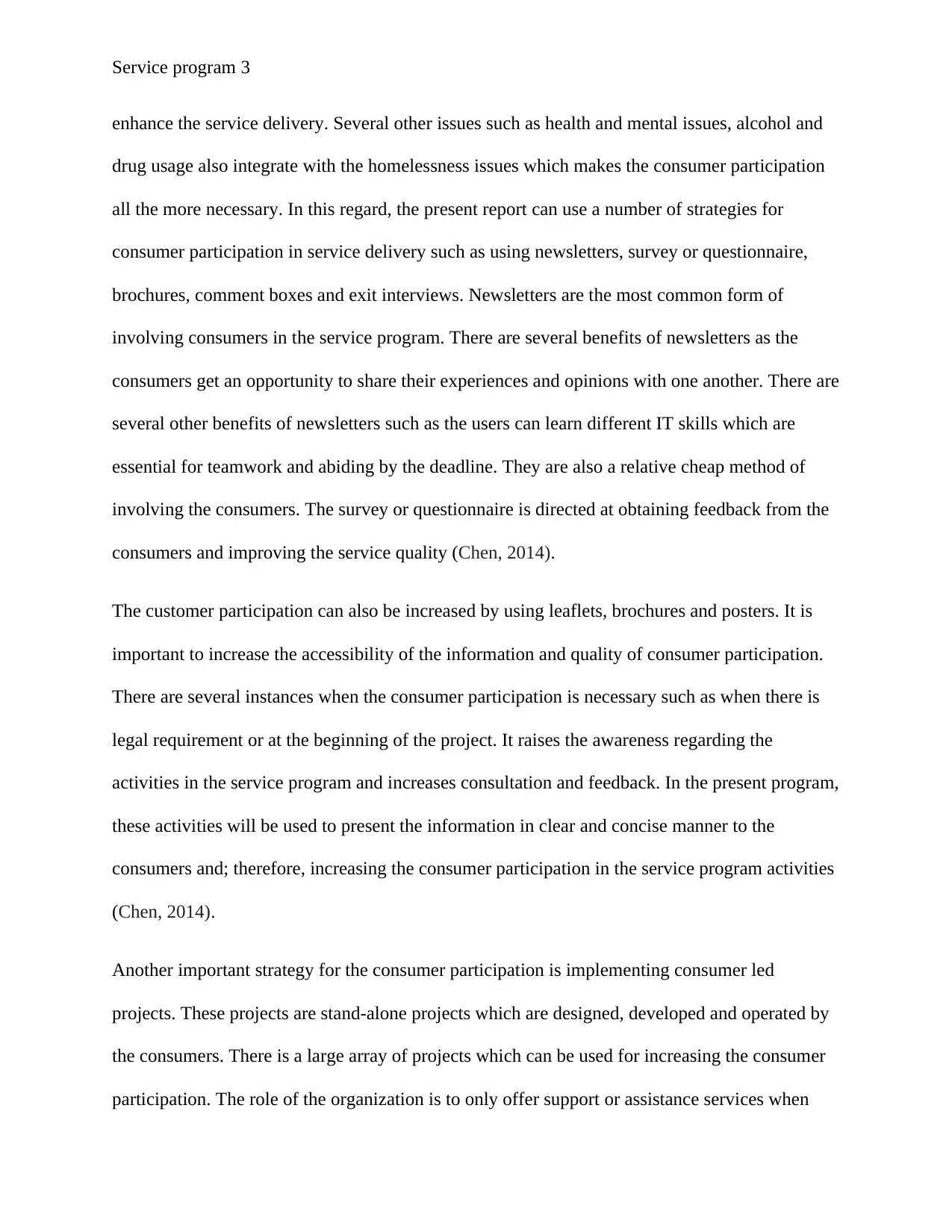
Service program 3
enhance the service delivery. Several other issues such as health and mental issues, alcohol and
drug usage also integrate with the homelessness issues which makes the consumer participation
all the more necessary. In this regard, the present report can use a number of strategies for
consumer participation in service delivery such as using newsletters, survey or questionnaire,
brochures, comment boxes and exit interviews. Newsletters are the most common form of
involving consumers in the service program. There are several benefits of newsletters as the
consumers get an opportunity to share their experiences and opinions with one another. There are
several other benefits of newsletters such as the users can learn different IT skills which are
essential for teamwork and abiding by the deadline. They are also a relative cheap method of
involving the consumers. The survey or questionnaire is directed at obtaining feedback from the
consumers and improving the service quality (Chen, 2014).
The customer participation can also be increased by using leaflets, brochures and posters. It is
important to increase the accessibility of the information and quality of consumer participation.
There are several instances when the consumer participation is necessary such as when there is
legal requirement or at the beginning of the project. It raises the awareness regarding the
activities in the service program and increases consultation and feedback. In the present program,
these activities will be used to present the information in clear and concise manner to the
consumers and; therefore, increasing the consumer participation in the service program activities
(Chen, 2014).
Another important strategy for the consumer participation is implementing consumer led
projects. These projects are stand-alone projects which are designed, developed and operated by
the consumers. There is a large array of projects which can be used for increasing the consumer
participation. The role of the organization is to only offer support or assistance services when
enhance the service delivery. Several other issues such as health and mental issues, alcohol and
drug usage also integrate with the homelessness issues which makes the consumer participation
all the more necessary. In this regard, the present report can use a number of strategies for
consumer participation in service delivery such as using newsletters, survey or questionnaire,
brochures, comment boxes and exit interviews. Newsletters are the most common form of
involving consumers in the service program. There are several benefits of newsletters as the
consumers get an opportunity to share their experiences and opinions with one another. There are
several other benefits of newsletters such as the users can learn different IT skills which are
essential for teamwork and abiding by the deadline. They are also a relative cheap method of
involving the consumers. The survey or questionnaire is directed at obtaining feedback from the
consumers and improving the service quality (Chen, 2014).
The customer participation can also be increased by using leaflets, brochures and posters. It is
important to increase the accessibility of the information and quality of consumer participation.
There are several instances when the consumer participation is necessary such as when there is
legal requirement or at the beginning of the project. It raises the awareness regarding the
activities in the service program and increases consultation and feedback. In the present program,
these activities will be used to present the information in clear and concise manner to the
consumers and; therefore, increasing the consumer participation in the service program activities
(Chen, 2014).
Another important strategy for the consumer participation is implementing consumer led
projects. These projects are stand-alone projects which are designed, developed and operated by
the consumers. There is a large array of projects which can be used for increasing the consumer
participation. The role of the organization is to only offer support or assistance services when
⊘ This is a preview!⊘
Do you want full access?
Subscribe today to unlock all pages.

Trusted by 1+ million students worldwide
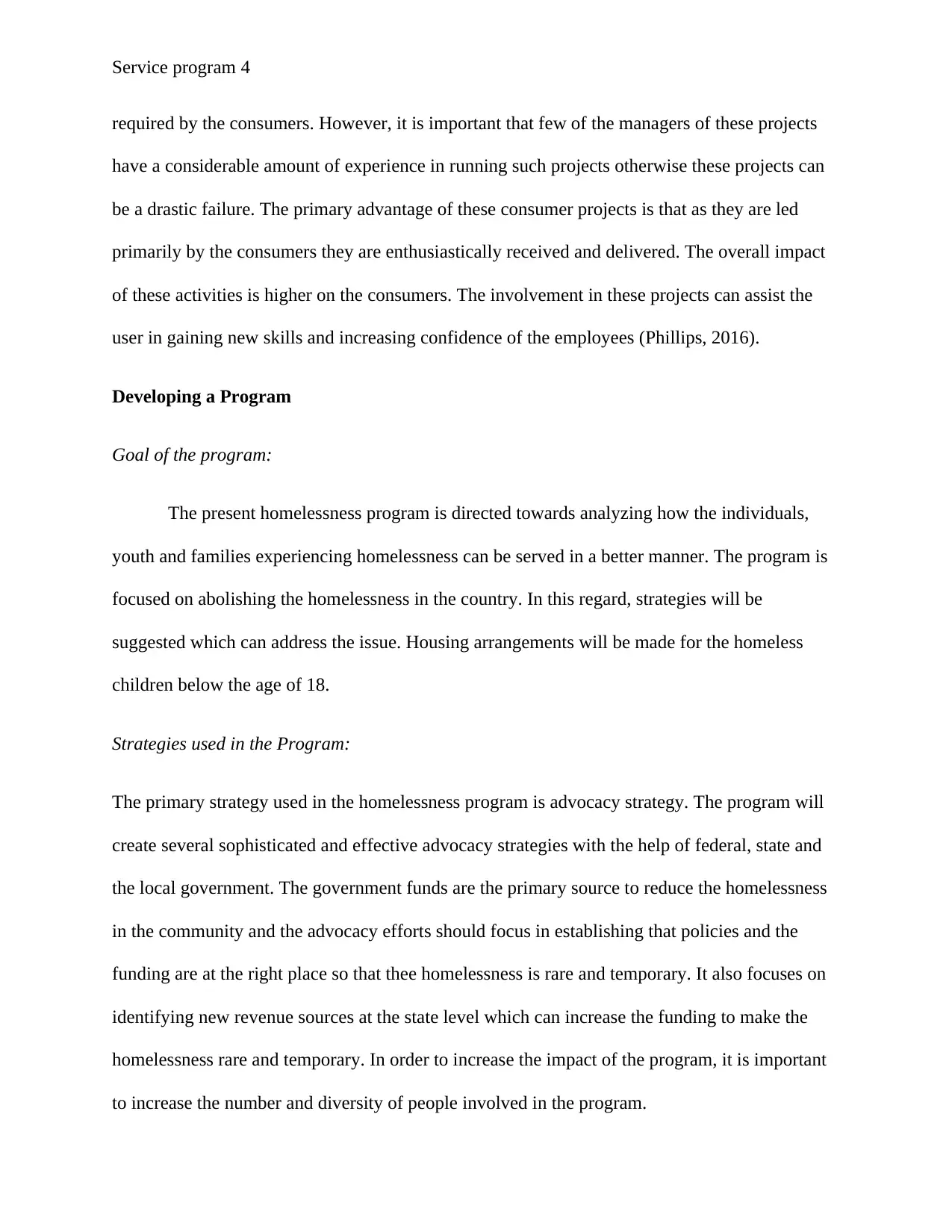
Service program 4
required by the consumers. However, it is important that few of the managers of these projects
have a considerable amount of experience in running such projects otherwise these projects can
be a drastic failure. The primary advantage of these consumer projects is that as they are led
primarily by the consumers they are enthusiastically received and delivered. The overall impact
of these activities is higher on the consumers. The involvement in these projects can assist the
user in gaining new skills and increasing confidence of the employees (Phillips, 2016).
Developing a Program
Goal of the program:
The present homelessness program is directed towards analyzing how the individuals,
youth and families experiencing homelessness can be served in a better manner. The program is
focused on abolishing the homelessness in the country. In this regard, strategies will be
suggested which can address the issue. Housing arrangements will be made for the homeless
children below the age of 18.
Strategies used in the Program:
The primary strategy used in the homelessness program is advocacy strategy. The program will
create several sophisticated and effective advocacy strategies with the help of federal, state and
the local government. The government funds are the primary source to reduce the homelessness
in the community and the advocacy efforts should focus in establishing that policies and the
funding are at the right place so that thee homelessness is rare and temporary. It also focuses on
identifying new revenue sources at the state level which can increase the funding to make the
homelessness rare and temporary. In order to increase the impact of the program, it is important
to increase the number and diversity of people involved in the program.
required by the consumers. However, it is important that few of the managers of these projects
have a considerable amount of experience in running such projects otherwise these projects can
be a drastic failure. The primary advantage of these consumer projects is that as they are led
primarily by the consumers they are enthusiastically received and delivered. The overall impact
of these activities is higher on the consumers. The involvement in these projects can assist the
user in gaining new skills and increasing confidence of the employees (Phillips, 2016).
Developing a Program
Goal of the program:
The present homelessness program is directed towards analyzing how the individuals,
youth and families experiencing homelessness can be served in a better manner. The program is
focused on abolishing the homelessness in the country. In this regard, strategies will be
suggested which can address the issue. Housing arrangements will be made for the homeless
children below the age of 18.
Strategies used in the Program:
The primary strategy used in the homelessness program is advocacy strategy. The program will
create several sophisticated and effective advocacy strategies with the help of federal, state and
the local government. The government funds are the primary source to reduce the homelessness
in the community and the advocacy efforts should focus in establishing that policies and the
funding are at the right place so that thee homelessness is rare and temporary. It also focuses on
identifying new revenue sources at the state level which can increase the funding to make the
homelessness rare and temporary. In order to increase the impact of the program, it is important
to increase the number and diversity of people involved in the program.
Paraphrase This Document
Need a fresh take? Get an instant paraphrase of this document with our AI Paraphraser
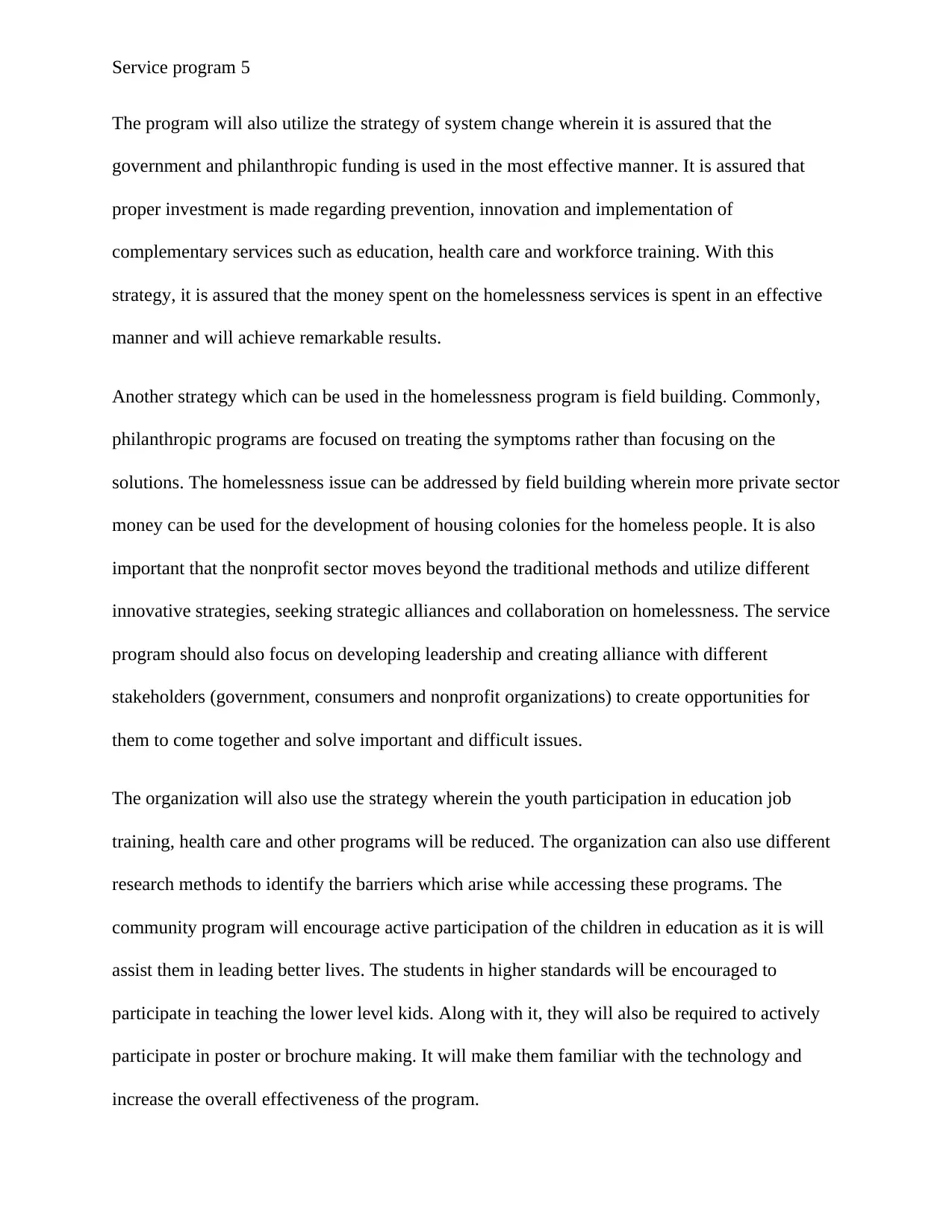
Service program 5
The program will also utilize the strategy of system change wherein it is assured that the
government and philanthropic funding is used in the most effective manner. It is assured that
proper investment is made regarding prevention, innovation and implementation of
complementary services such as education, health care and workforce training. With this
strategy, it is assured that the money spent on the homelessness services is spent in an effective
manner and will achieve remarkable results.
Another strategy which can be used in the homelessness program is field building. Commonly,
philanthropic programs are focused on treating the symptoms rather than focusing on the
solutions. The homelessness issue can be addressed by field building wherein more private sector
money can be used for the development of housing colonies for the homeless people. It is also
important that the nonprofit sector moves beyond the traditional methods and utilize different
innovative strategies, seeking strategic alliances and collaboration on homelessness. The service
program should also focus on developing leadership and creating alliance with different
stakeholders (government, consumers and nonprofit organizations) to create opportunities for
them to come together and solve important and difficult issues.
The organization will also use the strategy wherein the youth participation in education job
training, health care and other programs will be reduced. The organization can also use different
research methods to identify the barriers which arise while accessing these programs. The
community program will encourage active participation of the children in education as it is will
assist them in leading better lives. The students in higher standards will be encouraged to
participate in teaching the lower level kids. Along with it, they will also be required to actively
participate in poster or brochure making. It will make them familiar with the technology and
increase the overall effectiveness of the program.
The program will also utilize the strategy of system change wherein it is assured that the
government and philanthropic funding is used in the most effective manner. It is assured that
proper investment is made regarding prevention, innovation and implementation of
complementary services such as education, health care and workforce training. With this
strategy, it is assured that the money spent on the homelessness services is spent in an effective
manner and will achieve remarkable results.
Another strategy which can be used in the homelessness program is field building. Commonly,
philanthropic programs are focused on treating the symptoms rather than focusing on the
solutions. The homelessness issue can be addressed by field building wherein more private sector
money can be used for the development of housing colonies for the homeless people. It is also
important that the nonprofit sector moves beyond the traditional methods and utilize different
innovative strategies, seeking strategic alliances and collaboration on homelessness. The service
program should also focus on developing leadership and creating alliance with different
stakeholders (government, consumers and nonprofit organizations) to create opportunities for
them to come together and solve important and difficult issues.
The organization will also use the strategy wherein the youth participation in education job
training, health care and other programs will be reduced. The organization can also use different
research methods to identify the barriers which arise while accessing these programs. The
community program will encourage active participation of the children in education as it is will
assist them in leading better lives. The students in higher standards will be encouraged to
participate in teaching the lower level kids. Along with it, they will also be required to actively
participate in poster or brochure making. It will make them familiar with the technology and
increase the overall effectiveness of the program.
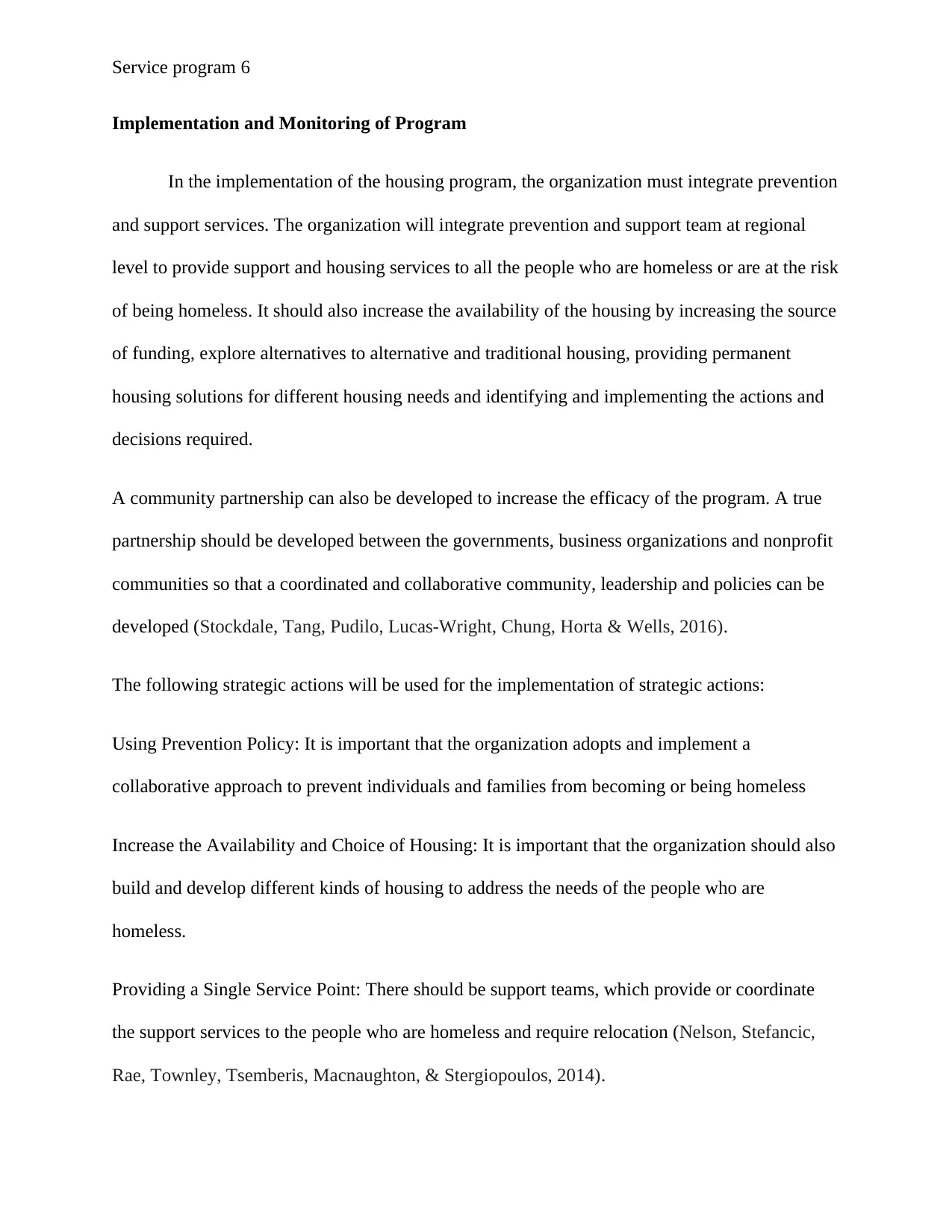
Service program 6
Implementation and Monitoring of Program
In the implementation of the housing program, the organization must integrate prevention
and support services. The organization will integrate prevention and support team at regional
level to provide support and housing services to all the people who are homeless or are at the risk
of being homeless. It should also increase the availability of the housing by increasing the source
of funding, explore alternatives to alternative and traditional housing, providing permanent
housing solutions for different housing needs and identifying and implementing the actions and
decisions required.
A community partnership can also be developed to increase the efficacy of the program. A true
partnership should be developed between the governments, business organizations and nonprofit
communities so that a coordinated and collaborative community, leadership and policies can be
developed (Stockdale, Tang, Pudilo, Lucas-Wright, Chung, Horta & Wells, 2016).
The following strategic actions will be used for the implementation of strategic actions:
Using Prevention Policy: It is important that the organization adopts and implement a
collaborative approach to prevent individuals and families from becoming or being homeless
Increase the Availability and Choice of Housing: It is important that the organization should also
build and develop different kinds of housing to address the needs of the people who are
homeless.
Providing a Single Service Point: There should be support teams, which provide or coordinate
the support services to the people who are homeless and require relocation (Nelson, Stefancic,
Rae, Townley, Tsemberis, Macnaughton, & Stergiopoulos, 2014).
Implementation and Monitoring of Program
In the implementation of the housing program, the organization must integrate prevention
and support services. The organization will integrate prevention and support team at regional
level to provide support and housing services to all the people who are homeless or are at the risk
of being homeless. It should also increase the availability of the housing by increasing the source
of funding, explore alternatives to alternative and traditional housing, providing permanent
housing solutions for different housing needs and identifying and implementing the actions and
decisions required.
A community partnership can also be developed to increase the efficacy of the program. A true
partnership should be developed between the governments, business organizations and nonprofit
communities so that a coordinated and collaborative community, leadership and policies can be
developed (Stockdale, Tang, Pudilo, Lucas-Wright, Chung, Horta & Wells, 2016).
The following strategic actions will be used for the implementation of strategic actions:
Using Prevention Policy: It is important that the organization adopts and implement a
collaborative approach to prevent individuals and families from becoming or being homeless
Increase the Availability and Choice of Housing: It is important that the organization should also
build and develop different kinds of housing to address the needs of the people who are
homeless.
Providing a Single Service Point: There should be support teams, which provide or coordinate
the support services to the people who are homeless and require relocation (Nelson, Stefancic,
Rae, Townley, Tsemberis, Macnaughton, & Stergiopoulos, 2014).
⊘ This is a preview!⊘
Do you want full access?
Subscribe today to unlock all pages.

Trusted by 1+ million students worldwide
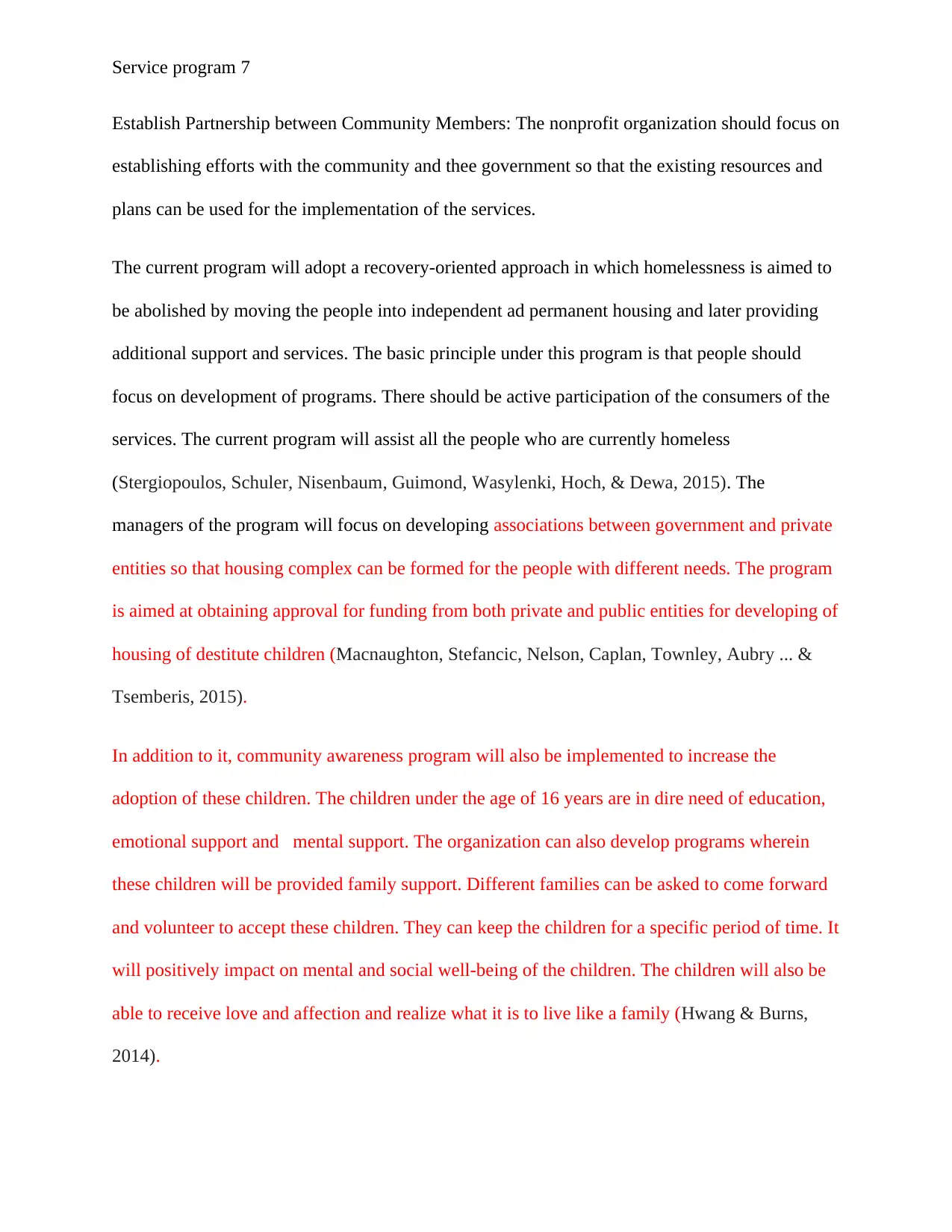
Service program 7
Establish Partnership between Community Members: The nonprofit organization should focus on
establishing efforts with the community and thee government so that the existing resources and
plans can be used for the implementation of the services.
The current program will adopt a recovery-oriented approach in which homelessness is aimed to
be abolished by moving the people into independent ad permanent housing and later providing
additional support and services. The basic principle under this program is that people should
focus on development of programs. There should be active participation of the consumers of the
services. The current program will assist all the people who are currently homeless
(Stergiopoulos, Schuler, Nisenbaum, Guimond, Wasylenki, Hoch, & Dewa, 2015). The
managers of the program will focus on developing associations between government and private
entities so that housing complex can be formed for the people with different needs. The program
is aimed at obtaining approval for funding from both private and public entities for developing of
housing of destitute children (Macnaughton, Stefancic, Nelson, Caplan, Townley, Aubry ... &
Tsemberis, 2015).
In addition to it, community awareness program will also be implemented to increase the
adoption of these children. The children under the age of 16 years are in dire need of education,
emotional support and mental support. The organization can also develop programs wherein
these children will be provided family support. Different families can be asked to come forward
and volunteer to accept these children. They can keep the children for a specific period of time. It
will positively impact on mental and social well-being of the children. The children will also be
able to receive love and affection and realize what it is to live like a family (Hwang & Burns,
2014).
Establish Partnership between Community Members: The nonprofit organization should focus on
establishing efforts with the community and thee government so that the existing resources and
plans can be used for the implementation of the services.
The current program will adopt a recovery-oriented approach in which homelessness is aimed to
be abolished by moving the people into independent ad permanent housing and later providing
additional support and services. The basic principle under this program is that people should
focus on development of programs. There should be active participation of the consumers of the
services. The current program will assist all the people who are currently homeless
(Stergiopoulos, Schuler, Nisenbaum, Guimond, Wasylenki, Hoch, & Dewa, 2015). The
managers of the program will focus on developing associations between government and private
entities so that housing complex can be formed for the people with different needs. The program
is aimed at obtaining approval for funding from both private and public entities for developing of
housing of destitute children (Macnaughton, Stefancic, Nelson, Caplan, Townley, Aubry ... &
Tsemberis, 2015).
In addition to it, community awareness program will also be implemented to increase the
adoption of these children. The children under the age of 16 years are in dire need of education,
emotional support and mental support. The organization can also develop programs wherein
these children will be provided family support. Different families can be asked to come forward
and volunteer to accept these children. They can keep the children for a specific period of time. It
will positively impact on mental and social well-being of the children. The children will also be
able to receive love and affection and realize what it is to live like a family (Hwang & Burns,
2014).
Paraphrase This Document
Need a fresh take? Get an instant paraphrase of this document with our AI Paraphraser
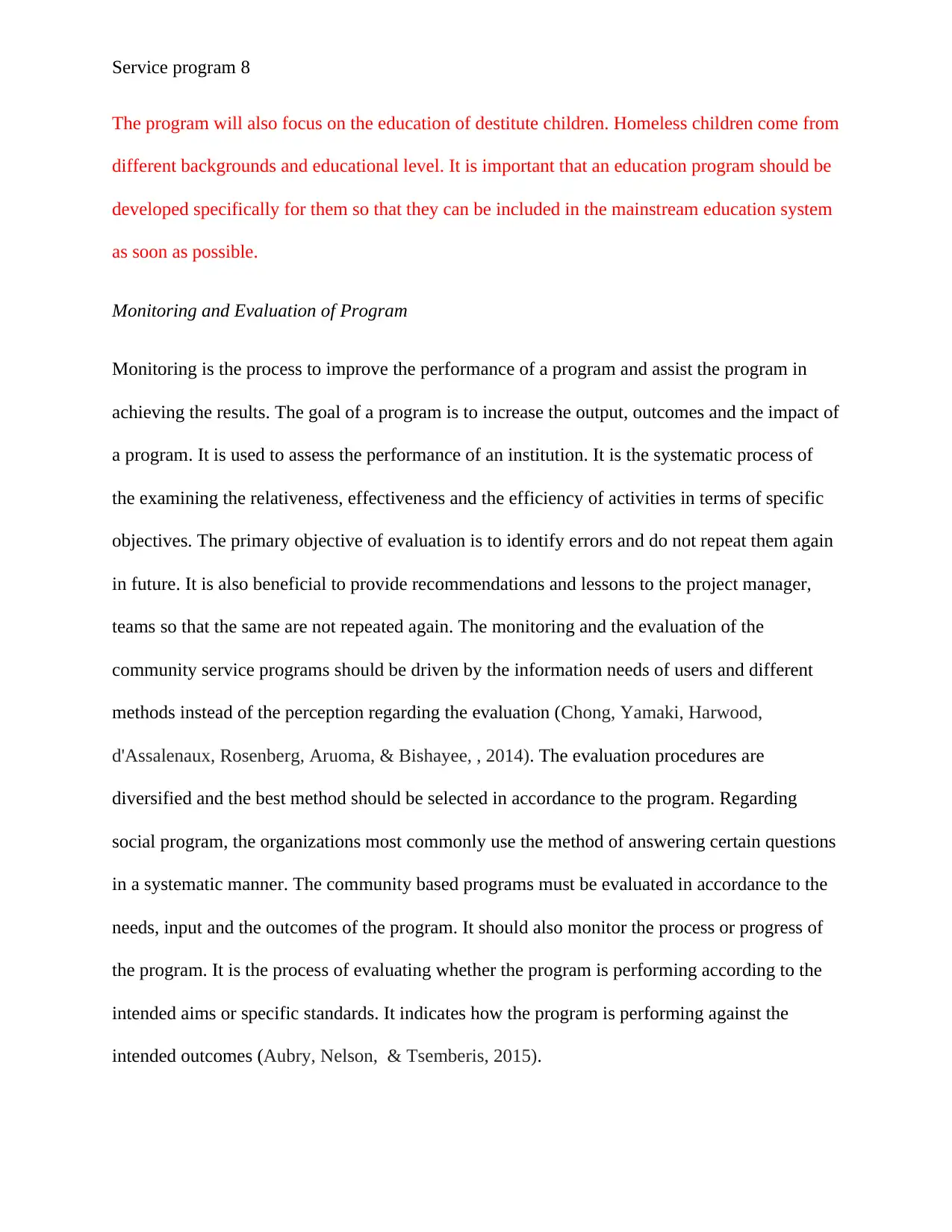
Service program 8
The program will also focus on the education of destitute children. Homeless children come from
different backgrounds and educational level. It is important that an education program should be
developed specifically for them so that they can be included in the mainstream education system
as soon as possible.
Monitoring and Evaluation of Program
Monitoring is the process to improve the performance of a program and assist the program in
achieving the results. The goal of a program is to increase the output, outcomes and the impact of
a program. It is used to assess the performance of an institution. It is the systematic process of
the examining the relativeness, effectiveness and the efficiency of activities in terms of specific
objectives. The primary objective of evaluation is to identify errors and do not repeat them again
in future. It is also beneficial to provide recommendations and lessons to the project manager,
teams so that the same are not repeated again. The monitoring and the evaluation of the
community service programs should be driven by the information needs of users and different
methods instead of the perception regarding the evaluation (Chong, Yamaki, Harwood,
d'Assalenaux, Rosenberg, Aruoma, & Bishayee, , 2014). The evaluation procedures are
diversified and the best method should be selected in accordance to the program. Regarding
social program, the organizations most commonly use the method of answering certain questions
in a systematic manner. The community based programs must be evaluated in accordance to the
needs, input and the outcomes of the program. It should also monitor the process or progress of
the program. It is the process of evaluating whether the program is performing according to the
intended aims or specific standards. It indicates how the program is performing against the
intended outcomes (Aubry, Nelson, & Tsemberis, 2015).
The program will also focus on the education of destitute children. Homeless children come from
different backgrounds and educational level. It is important that an education program should be
developed specifically for them so that they can be included in the mainstream education system
as soon as possible.
Monitoring and Evaluation of Program
Monitoring is the process to improve the performance of a program and assist the program in
achieving the results. The goal of a program is to increase the output, outcomes and the impact of
a program. It is used to assess the performance of an institution. It is the systematic process of
the examining the relativeness, effectiveness and the efficiency of activities in terms of specific
objectives. The primary objective of evaluation is to identify errors and do not repeat them again
in future. It is also beneficial to provide recommendations and lessons to the project manager,
teams so that the same are not repeated again. The monitoring and the evaluation of the
community service programs should be driven by the information needs of users and different
methods instead of the perception regarding the evaluation (Chong, Yamaki, Harwood,
d'Assalenaux, Rosenberg, Aruoma, & Bishayee, , 2014). The evaluation procedures are
diversified and the best method should be selected in accordance to the program. Regarding
social program, the organizations most commonly use the method of answering certain questions
in a systematic manner. The community based programs must be evaluated in accordance to the
needs, input and the outcomes of the program. It should also monitor the process or progress of
the program. It is the process of evaluating whether the program is performing according to the
intended aims or specific standards. It indicates how the program is performing against the
intended outcomes (Aubry, Nelson, & Tsemberis, 2015).
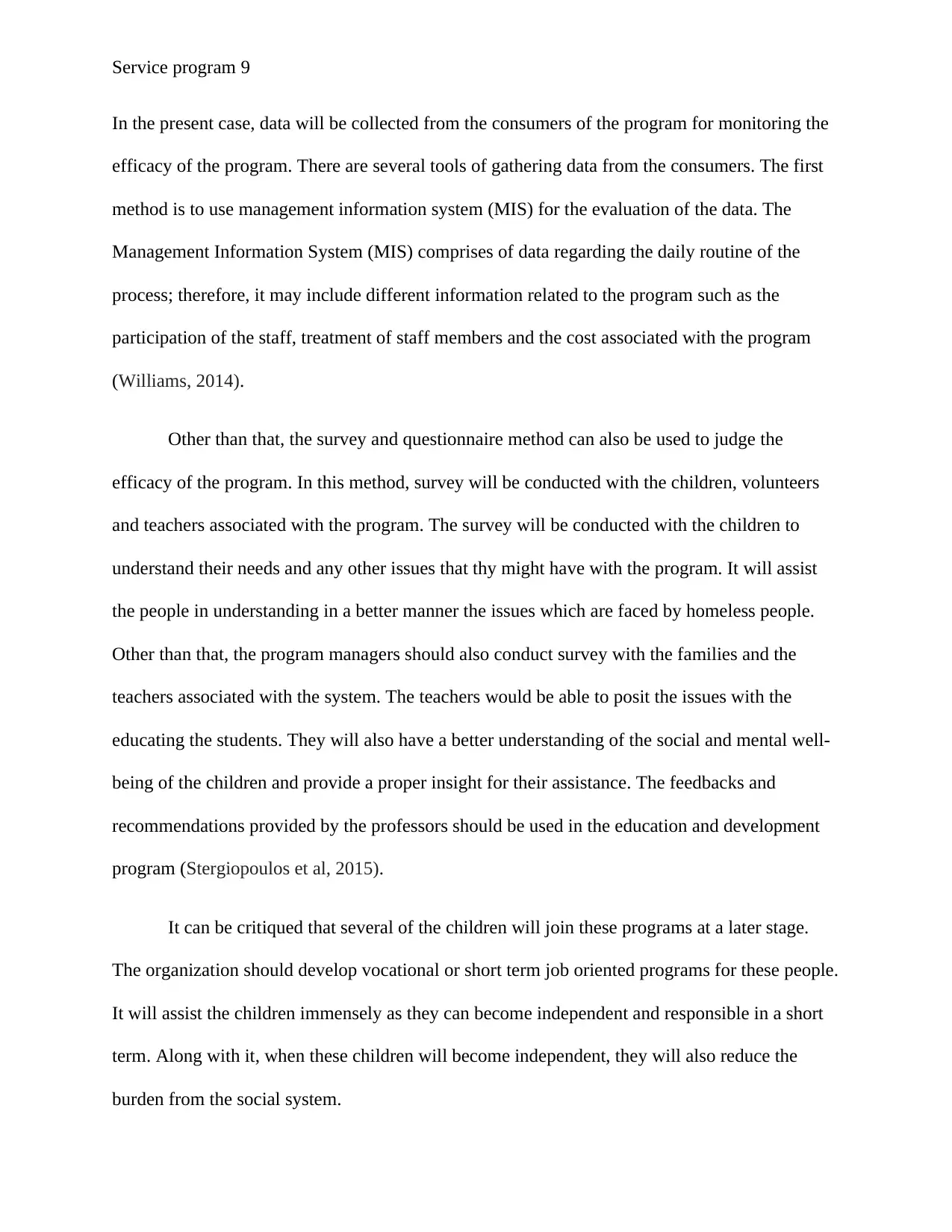
Service program 9
In the present case, data will be collected from the consumers of the program for monitoring the
efficacy of the program. There are several tools of gathering data from the consumers. The first
method is to use management information system (MIS) for the evaluation of the data. The
Management Information System (MIS) comprises of data regarding the daily routine of the
process; therefore, it may include different information related to the program such as the
participation of the staff, treatment of staff members and the cost associated with the program
(Williams, 2014).
Other than that, the survey and questionnaire method can also be used to judge the
efficacy of the program. In this method, survey will be conducted with the children, volunteers
and teachers associated with the program. The survey will be conducted with the children to
understand their needs and any other issues that thy might have with the program. It will assist
the people in understanding in a better manner the issues which are faced by homeless people.
Other than that, the program managers should also conduct survey with the families and the
teachers associated with the system. The teachers would be able to posit the issues with the
educating the students. They will also have a better understanding of the social and mental well-
being of the children and provide a proper insight for their assistance. The feedbacks and
recommendations provided by the professors should be used in the education and development
program (Stergiopoulos et al, 2015).
It can be critiqued that several of the children will join these programs at a later stage.
The organization should develop vocational or short term job oriented programs for these people.
It will assist the children immensely as they can become independent and responsible in a short
term. Along with it, when these children will become independent, they will also reduce the
burden from the social system.
In the present case, data will be collected from the consumers of the program for monitoring the
efficacy of the program. There are several tools of gathering data from the consumers. The first
method is to use management information system (MIS) for the evaluation of the data. The
Management Information System (MIS) comprises of data regarding the daily routine of the
process; therefore, it may include different information related to the program such as the
participation of the staff, treatment of staff members and the cost associated with the program
(Williams, 2014).
Other than that, the survey and questionnaire method can also be used to judge the
efficacy of the program. In this method, survey will be conducted with the children, volunteers
and teachers associated with the program. The survey will be conducted with the children to
understand their needs and any other issues that thy might have with the program. It will assist
the people in understanding in a better manner the issues which are faced by homeless people.
Other than that, the program managers should also conduct survey with the families and the
teachers associated with the system. The teachers would be able to posit the issues with the
educating the students. They will also have a better understanding of the social and mental well-
being of the children and provide a proper insight for their assistance. The feedbacks and
recommendations provided by the professors should be used in the education and development
program (Stergiopoulos et al, 2015).
It can be critiqued that several of the children will join these programs at a later stage.
The organization should develop vocational or short term job oriented programs for these people.
It will assist the children immensely as they can become independent and responsible in a short
term. Along with it, when these children will become independent, they will also reduce the
burden from the social system.
⊘ This is a preview!⊘
Do you want full access?
Subscribe today to unlock all pages.

Trusted by 1+ million students worldwide
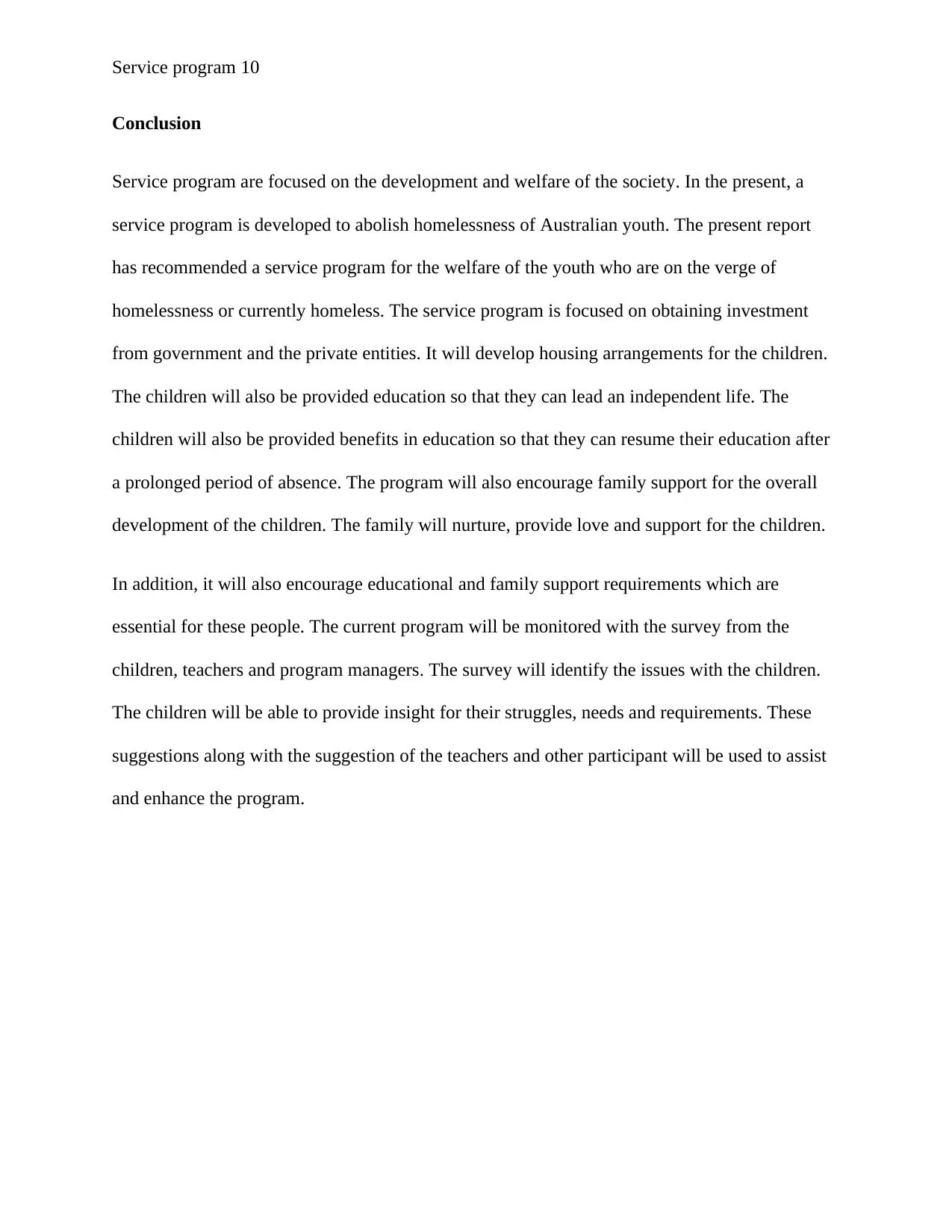
Service program 10
Conclusion
Service program are focused on the development and welfare of the society. In the present, a
service program is developed to abolish homelessness of Australian youth. The present report
has recommended a service program for the welfare of the youth who are on the verge of
homelessness or currently homeless. The service program is focused on obtaining investment
from government and the private entities. It will develop housing arrangements for the children.
The children will also be provided education so that they can lead an independent life. The
children will also be provided benefits in education so that they can resume their education after
a prolonged period of absence. The program will also encourage family support for the overall
development of the children. The family will nurture, provide love and support for the children.
In addition, it will also encourage educational and family support requirements which are
essential for these people. The current program will be monitored with the survey from the
children, teachers and program managers. The survey will identify the issues with the children.
The children will be able to provide insight for their struggles, needs and requirements. These
suggestions along with the suggestion of the teachers and other participant will be used to assist
and enhance the program.
Conclusion
Service program are focused on the development and welfare of the society. In the present, a
service program is developed to abolish homelessness of Australian youth. The present report
has recommended a service program for the welfare of the youth who are on the verge of
homelessness or currently homeless. The service program is focused on obtaining investment
from government and the private entities. It will develop housing arrangements for the children.
The children will also be provided education so that they can lead an independent life. The
children will also be provided benefits in education so that they can resume their education after
a prolonged period of absence. The program will also encourage family support for the overall
development of the children. The family will nurture, provide love and support for the children.
In addition, it will also encourage educational and family support requirements which are
essential for these people. The current program will be monitored with the survey from the
children, teachers and program managers. The survey will identify the issues with the children.
The children will be able to provide insight for their struggles, needs and requirements. These
suggestions along with the suggestion of the teachers and other participant will be used to assist
and enhance the program.
Paraphrase This Document
Need a fresh take? Get an instant paraphrase of this document with our AI Paraphraser
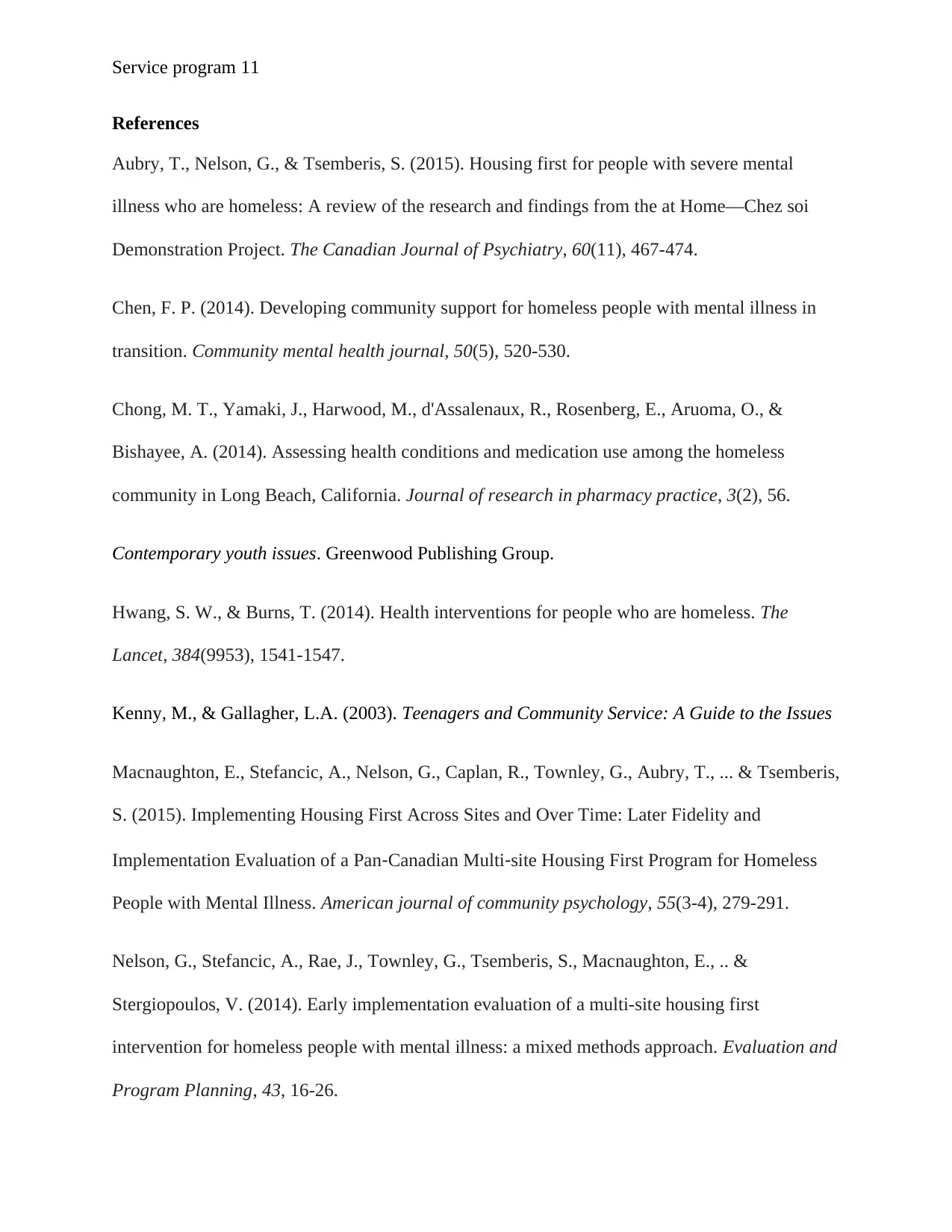
Service program 11
References
Aubry, T., Nelson, G., & Tsemberis, S. (2015). Housing first for people with severe mental
illness who are homeless: A review of the research and findings from the at Home—Chez soi
Demonstration Project. The Canadian Journal of Psychiatry, 60(11), 467-474.
Chen, F. P. (2014). Developing community support for homeless people with mental illness in
transition. Community mental health journal, 50(5), 520-530.
Chong, M. T., Yamaki, J., Harwood, M., d'Assalenaux, R., Rosenberg, E., Aruoma, O., &
Bishayee, A. (2014). Assessing health conditions and medication use among the homeless
community in Long Beach, California. Journal of research in pharmacy practice, 3(2), 56.
Contemporary youth issues. Greenwood Publishing Group.
Hwang, S. W., & Burns, T. (2014). Health interventions for people who are homeless. The
Lancet, 384(9953), 1541-1547.
Kenny, M., & Gallagher, L.A. (2003). Teenagers and Community Service: A Guide to the Issues
Macnaughton, E., Stefancic, A., Nelson, G., Caplan, R., Townley, G., Aubry, T., ... & Tsemberis,
S. (2015). Implementing Housing First Across Sites and Over Time: Later Fidelity and
Implementation Evaluation of a Pan‐Canadian Multi‐site Housing First Program for Homeless
People with Mental Illness. American journal of community psychology, 55(3-4), 279-291.
Nelson, G., Stefancic, A., Rae, J., Townley, G., Tsemberis, S., Macnaughton, E., .. &
Stergiopoulos, V. (2014). Early implementation evaluation of a multi-site housing first
intervention for homeless people with mental illness: a mixed methods approach. Evaluation and
Program Planning, 43, 16-26.
References
Aubry, T., Nelson, G., & Tsemberis, S. (2015). Housing first for people with severe mental
illness who are homeless: A review of the research and findings from the at Home—Chez soi
Demonstration Project. The Canadian Journal of Psychiatry, 60(11), 467-474.
Chen, F. P. (2014). Developing community support for homeless people with mental illness in
transition. Community mental health journal, 50(5), 520-530.
Chong, M. T., Yamaki, J., Harwood, M., d'Assalenaux, R., Rosenberg, E., Aruoma, O., &
Bishayee, A. (2014). Assessing health conditions and medication use among the homeless
community in Long Beach, California. Journal of research in pharmacy practice, 3(2), 56.
Contemporary youth issues. Greenwood Publishing Group.
Hwang, S. W., & Burns, T. (2014). Health interventions for people who are homeless. The
Lancet, 384(9953), 1541-1547.
Kenny, M., & Gallagher, L.A. (2003). Teenagers and Community Service: A Guide to the Issues
Macnaughton, E., Stefancic, A., Nelson, G., Caplan, R., Townley, G., Aubry, T., ... & Tsemberis,
S. (2015). Implementing Housing First Across Sites and Over Time: Later Fidelity and
Implementation Evaluation of a Pan‐Canadian Multi‐site Housing First Program for Homeless
People with Mental Illness. American journal of community psychology, 55(3-4), 279-291.
Nelson, G., Stefancic, A., Rae, J., Townley, G., Tsemberis, S., Macnaughton, E., .. &
Stergiopoulos, V. (2014). Early implementation evaluation of a multi-site housing first
intervention for homeless people with mental illness: a mixed methods approach. Evaluation and
Program Planning, 43, 16-26.
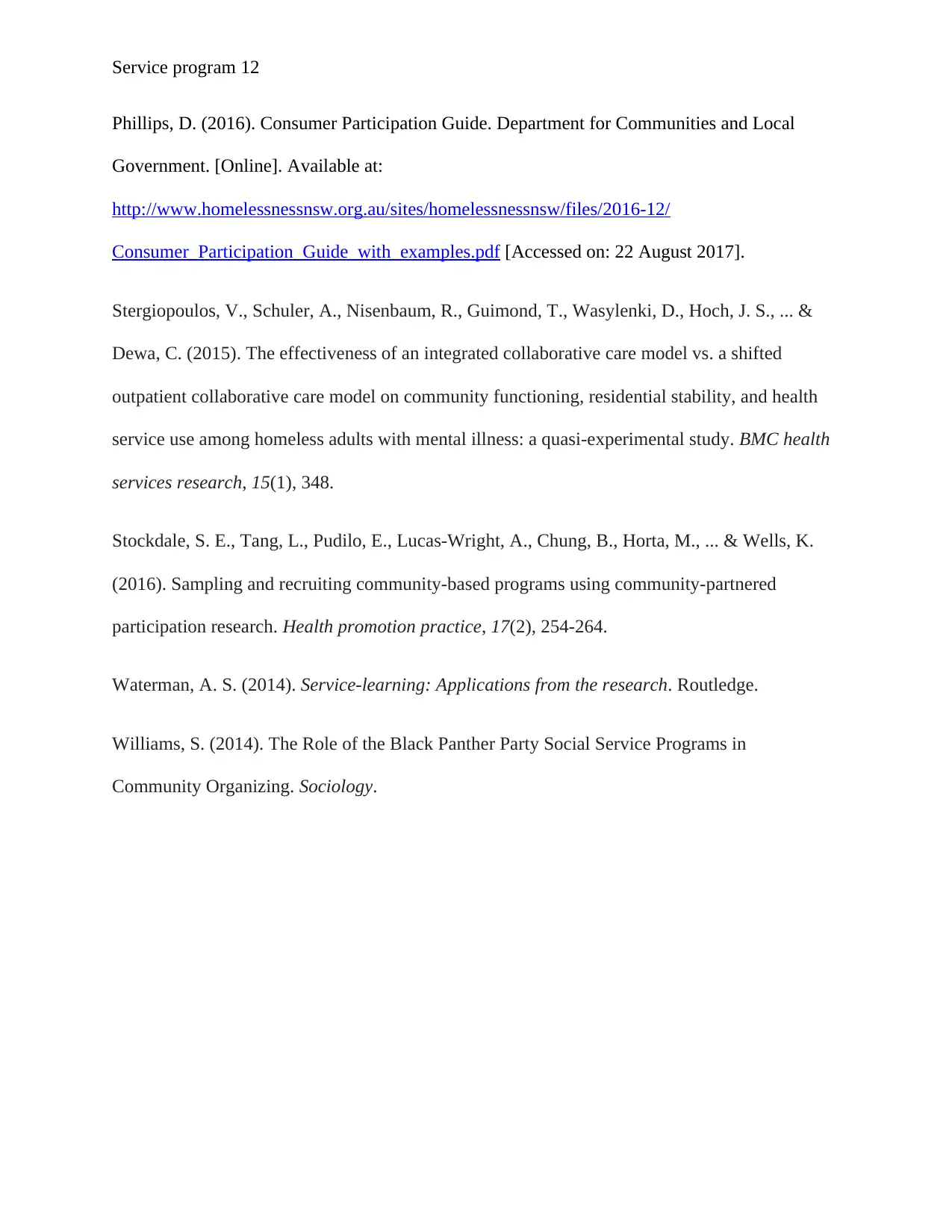
Service program 12
Phillips, D. (2016). Consumer Participation Guide. Department for Communities and Local
Government. [Online]. Available at:
http://www.homelessnessnsw.org.au/sites/homelessnessnsw/files/2016-12/
Consumer_Participation_Guide_with_examples.pdf [Accessed on: 22 August 2017].
Stergiopoulos, V., Schuler, A., Nisenbaum, R., Guimond, T., Wasylenki, D., Hoch, J. S., ... &
Dewa, C. (2015). The effectiveness of an integrated collaborative care model vs. a shifted
outpatient collaborative care model on community functioning, residential stability, and health
service use among homeless adults with mental illness: a quasi-experimental study. BMC health
services research, 15(1), 348.
Stockdale, S. E., Tang, L., Pudilo, E., Lucas-Wright, A., Chung, B., Horta, M., ... & Wells, K.
(2016). Sampling and recruiting community-based programs using community-partnered
participation research. Health promotion practice, 17(2), 254-264.
Waterman, A. S. (2014). Service-learning: Applications from the research. Routledge.
Williams, S. (2014). The Role of the Black Panther Party Social Service Programs in
Community Organizing. Sociology.
Phillips, D. (2016). Consumer Participation Guide. Department for Communities and Local
Government. [Online]. Available at:
http://www.homelessnessnsw.org.au/sites/homelessnessnsw/files/2016-12/
Consumer_Participation_Guide_with_examples.pdf [Accessed on: 22 August 2017].
Stergiopoulos, V., Schuler, A., Nisenbaum, R., Guimond, T., Wasylenki, D., Hoch, J. S., ... &
Dewa, C. (2015). The effectiveness of an integrated collaborative care model vs. a shifted
outpatient collaborative care model on community functioning, residential stability, and health
service use among homeless adults with mental illness: a quasi-experimental study. BMC health
services research, 15(1), 348.
Stockdale, S. E., Tang, L., Pudilo, E., Lucas-Wright, A., Chung, B., Horta, M., ... & Wells, K.
(2016). Sampling and recruiting community-based programs using community-partnered
participation research. Health promotion practice, 17(2), 254-264.
Waterman, A. S. (2014). Service-learning: Applications from the research. Routledge.
Williams, S. (2014). The Role of the Black Panther Party Social Service Programs in
Community Organizing. Sociology.
⊘ This is a preview!⊘
Do you want full access?
Subscribe today to unlock all pages.

Trusted by 1+ million students worldwide
1 out of 12
Related Documents
Your All-in-One AI-Powered Toolkit for Academic Success.
+13062052269
info@desklib.com
Available 24*7 on WhatsApp / Email
![[object Object]](/_next/static/media/star-bottom.7253800d.svg)
Unlock your academic potential
Copyright © 2020–2025 A2Z Services. All Rights Reserved. Developed and managed by ZUCOL.





